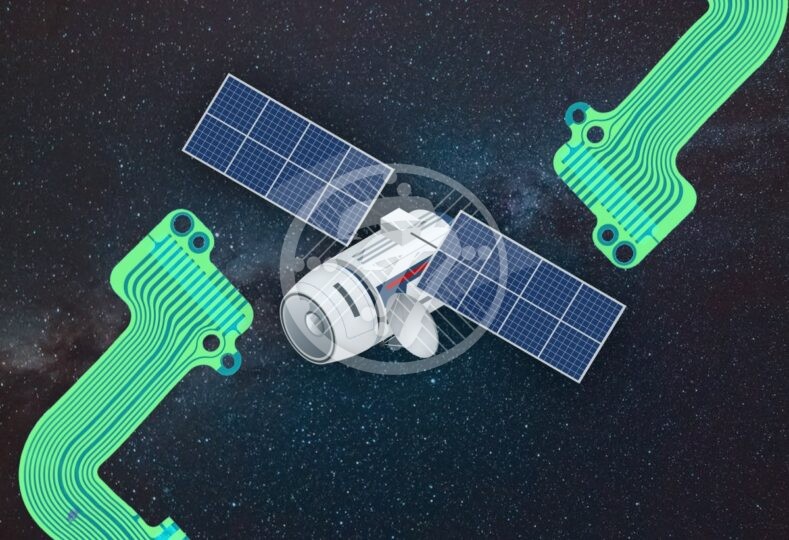What makes flexible PCB board the best choice for satellite applications?

When it comes to satellite applications, the use of flexible PCB boards is only growing! Not without reason! There are a large number of benefits that are pushing industry players towards the adoption of flexible PCBs. From reduced weight to increased reliability, there are a whole lot of advantages that flex PCB offer. Before we look at some of these advantages in detail, let us first understand how a satellite operates:
How does a satellite operate & what is its use case?
The satellite system has 3 main circuitries, namely:
- Satellite
- Receiver
- Transmitter
While the communication between a satellite & transmitter is referred to as uplink, the one between the satellite & receiver is referred to as downlink.
The use cases of satellites include:
- Disaster risk management
- Weather Forecast
- Remote Sensing
- Geo-Positioning
- Navigation
- Telecommunication
- Emergency Response Monitoring
Satellites, in turn, can be of 3 types, Fixed, Mobile & Broadcast, depending on the services they offer. A Fixed Satellite Service uses fixed receiving stations. These are primarily used in cable TV and internet stations. Mobile satellite services also deal with mobile systems for communication with fleet vehicles. Broadcast Satellite Service broadcasts TV & radio signals.
Given the functions that satellites perform, let us now look at the need for flex PCBs in satellite applications.
Advantages of using flexible PCB board in satellite applications
Reliability
Satellites represent mission critical operations and failure can come at an extremely high cost. It is imperative therefore that the PCB being used is extremely reliable. With flexible PCBs being able to withstand higher stress than rigid ones, they are suited for use in satellites that are subject to harsh environmental conditions. Additionally, Flex PCBs take away the use of connectors, which often cause interconnection failures. You are therefore assured of reliability when it comes to the use of flex PCBs in satellites.
Adaptability
The big advantage that flex PCBs offer is they are extremely adaptable, and land lends itself to shapes that ’t regular. Flex PCBs can fit into different surfaces that they are mounted on. However, this is not possible with rigid PCBs that cannot be used in complex shapes.
Their flexibility also comes in handy when you need extensible parts. With flexible circuits you can make use of expendable equipment without any fear of wear & tear.
Lightweight
With thinner copper layers as well as insulating layers, flex circuits are lightweight and can also adapt to tighter spaces with low bend radius.
While flexible circuits are made out of many materials, Kapton is particularly widely used because of its light weight. In addition, it is also known for its mechanical properties as well as vibration resistance.
While Flex PCBs are therefore well suited for use in satellites, it is imperative that PCB designers take the following conditions into account while designing PCBs for satellites:
Operating Temperature
It is important that the material chosen for PCBs to be deployed in satellites is suited for the harsh operating conditions. In fact, the material chosen should be able to survive in elevated temperatures of 120 degrees Celsius, or more.
Outgassing
When a PCB operates in a high-pressure environment, the gases trapped in the PCB are released. The gas released can condense on other sections and cause operational issues. It is therefore important to choose a material with good thermal resistance so that outgassing is controlled.
Orbital Collisions
With satellites, orbital collisions can be a reality. The PCBs should therefore be able to withstand such collisions. To ensure that, the flexing capacity of the PCBs should be high.
PCB standards for use in satellites
Because of these unique issues, there are specific standards when it comes to space applications. The common standards include:
AS9100
Created by the International Aerospace Quality Group, this standard is useful for creating products for the aerospace industry. AS9100D is the latest standard that the aerospace industry needs to adhere to.
The other standards that Aerospace as well as military-grade PCB assemblies need to adhere to include:
- MIL-PRF-50884
- MIL-PRF-31032
- MIL-PRF-55110
To sum up
Rigid flex & fully flex PCBs offer several advantages over traditional PCBs. Their innovative design, reduced weight and more make them an ideal choice. It not only helps to minimize the size of the spacecraft but also improves reliability.
We have over 40 years of fabricating and assembling a wide variety of flexible aerospace PCB assemblies. With state-of-the-art equipment, we deliver the highest quality boards that you can rely on. Armed with an experienced flexible PCB board manufacturer team that can advise you on industry best practices, what you get when you join hands with us, isn’t just a vendor but a partner who is invested in your success. In case you have any questions, please feel free to contact us via email at [email protected].






